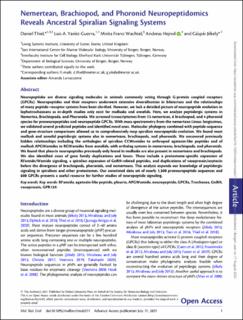Nemertean, Brachiopod, and Phoronid Neuropeptidomics Reveals Ancestral Spiralian Signaling Systems
Journal article, Peer reviewed
Published version

Åpne
Permanent lenke
https://hdl.handle.net/11250/2768697Utgivelsesdato
2021Metadata
Vis full innførselSamlinger
- Department of Biological Sciences [2289]
- Registrations from Cristin [10402]
Sammendrag
Neuropeptides are diverse signaling molecules in animals commonly acting through G-protein coupled receptors (GPCRs). Neuropeptides and their receptors underwent extensive diversification in bilaterians and the relationships of many peptide–receptor systems have been clarified. However, we lack a detailed picture of neuropeptide evolution in lophotrochozoans as in-depth studies only exist for mollusks and annelids. Here, we analyze peptidergic systems in Nemertea, Brachiopoda, and Phoronida. We screened transcriptomes from 13 nemertean, 6 brachiopod, and 4 phoronid species for proneuropeptides and neuropeptide GPCRs. With mass spectrometry from the nemertean Lineus longissimus, we validated several predicted peptides and identified novel ones. Molecular phylogeny combined with peptide-sequence and gene-structure comparisons allowed us to comprehensively map spiralian neuropeptide evolution. We found most mollusk and annelid peptidergic systems also in nemerteans, brachiopods, and phoronids. We uncovered previously hidden relationships including the orthologies of spiralian CCWamides to arthropod agatoxin-like peptides and of mollusk APGWamides to RGWamides from annelids, with ortholog systems in nemerteans, brachiopods, and phoronids. We found that pleurin neuropeptides previously only found in mollusks are also present in nemerteans and brachiopods. We also identified cases of gene family duplications and losses. These include a protostome-specific expansion of RFamide/Wamide signaling, a spiralian expansion of GnRH-related peptides, and duplications of vasopressin/oxytocin before the divergence of brachiopods, phoronids, and nemerteans. This analysis expands our knowledge of peptidergic signaling in spiralians and other protostomes. Our annotated data set of nearly 1,300 proneuropeptide sequences and 600 GPCRs presents a useful resource for further studies of neuropeptide signaling.
